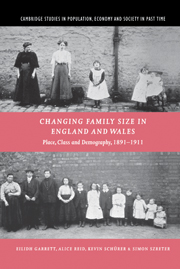Book contents
- Frontmatter
- Contents
- List of figures
- List of tables
- Preface and acknowledgements
- 1 Introduction
- 2 Locations for study
- 3 Studying locations
- 4 Infant and child mortality from the 1911 census
- 5 Fertility and fertility behaviour 1891–1911
- 6 The national picture
- 7 Class, place and demography: the mosaic of demographic change in England and Wales from Waterloo to the Great War
- Appendices
- References
- Index
- Cambridge Studies in Population, Economy and Society in Past Time
4 - Infant and child mortality from the 1911 census
Published online by Cambridge University Press: 05 January 2010
- Frontmatter
- Contents
- List of figures
- List of tables
- Preface and acknowledgements
- 1 Introduction
- 2 Locations for study
- 3 Studying locations
- 4 Infant and child mortality from the 1911 census
- 5 Fertility and fertility behaviour 1891–1911
- 6 The national picture
- 7 Class, place and demography: the mosaic of demographic change in England and Wales from Waterloo to the Great War
- Appendices
- References
- Index
- Cambridge Studies in Population, Economy and Society in Past Time
Summary
Introduction
This chapter focuses on the interactions between environment, social class, and infant and child mortality which were introduced in chapter 1. It sets out to enquire whether ‘who an individual was’ had a greater impact on their children's health than ‘where the family stayed’. Did, for example, high social class impart better health, or was it the ability of the wealthy to live in particularly salubrious surroundings which meant that the children of the better off were more likely to survive? The analysis undertaken also sought to elucidate which aspect of ‘social class’ or ‘environment’ had the greatest influence, or was most closely associated with mortality levels and trends amongst infants and young children at the close of the Victorian era.
Locational and social variables have been studied before in relation to infant and child mortality levels in the context of the nineteenth and early twentieth centuries. However, while Williams was able to address both ‘environment’ and class in her micro-study of Sheffield, assessments of the relative importance of location and social class variables have been precluded from large-scale studies by data limitations. The Registrar-General's reports and the aggregate tabulations in the 1911 census reports, to which most researchers are restricted, do not extend to cross-tabulations of social and locational variables.
- Type
- Chapter
- Information
- Changing Family Size in England and WalesPlace, Class and Demography, 1891–1911, pp. 105 - 209Publisher: Cambridge University PressPrint publication year: 2001
- 1
- Cited by

